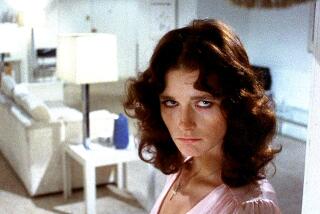‘400 Blows’ Captures Life, Art of Truffaut
- Share via
When Francois Truffaut burst upon the Cannes Film Festival with his first feature in 1959, he did more than capture the director’s prize. With “The 400 Blows,” the 27-year-old French film critic told the world here was a director who could not be ignored. A herald of the French New Wave, he spoke a cinematic and literary language with a unique poetic vision that drew not only from his personal experience, but also literature and film.
The Criterion Collection has just released a remarkable laser disc with French and English audio tracks that recaptures the sense of discovery that came with seeing this partially autobiographical film for the first time. The 94-minute CLV disc ($50) is presented in its original language and aspect ratio of 2.35:1 in a beautiful black-and-white transfer that, unfortunately, still retains some of the scratches of the original master. The wide banding of the letterboxing presents a fine background for the subtitles, which are newly adapted, but still include a few odd typos and translations. Small quibbles, though, for what this disc does offer.
Commentaries by Truffaut’s lifelong friend Robert Lacheney, whose childhood adventures with Truffaut become focal points of this film, offer insight into Truffaut’s life and art. Brian Stonehill, in the audio essay underlying the soundtrack, describes Truffaut’s approach to filmmaking as “cinema in the first person singular.” Commentary by Truffaut’s co-writer Marcel Moussy amplifies that observation.
Watching “The 400 Blows” unfold on location in and near Paris, it’s hard to believe that Truffaut shot the entire film silent, dubbing in all the sound in post-production. The young protagonist Antoine Doinel played by Jean-Pierre Leaud in his first film role is, as Stonehill observes, “astonishing--to call it brilliant doesn’t do it justice.”
Liner notes by Truffaut scholar Annette Insdorf also add important details that enhance the viewing experience and there are two audio commentary tracks, one in French, the other in English.
The only supplementary material on this disc is the film’s original trailer, which includes rave quotes from French film critics, and aptly conveys the feeling of the film, a contrast to too many American trailers.
Criterion has also just released Truffaut’s powerful 1961 film “Jules and Jim” ($50), based on the Henri-Pierre Roche novel featuring Jeanne Moreau, Oskar Werner, Henri Serre and Marie Dubois. Released in its original aspect ratio of 2.35:1, from a duplicate negative with new subtitle adaptations, it is a far superior experience compared to an earlier non-wide-screen version released by CBS Fox Video.
Like “The 400 Blows,” this 105-minute black-and-white film in its original French has rather wide banding, which makes for clear, unobtrusive subtitles. The two analog audio tracks, one in English, the other in French, include commentary from Truffaut collaborator Suzanne Schiffman, co-writer Jean Gruault, editor Claudine Bouche and Insdorf. Once more, the commentary adds immeasurably to an understanding of the film and the filmmaker, particularly in revealing how Truffaut worked with actors and allowed them to improvise, oftentimes to screenwriter Gruault’s frustration. The trailer is also offered.
MGM/UA Home Video has also just released in French with English subtitles, a letterbox edition of Truffaut’s 1968 homage to Hitchcock, “The Bride Wore Black” ($35). While it may not be the superlative cinematic experience that “400 Blows” or “Jules and Jim” are, it is nonetheless a far superior homage to the master of suspense than efforts by Brian De Palma or, more recently, Paul Verhoeven.
The 108-minute full-color film features a harder Moreau in an unrelenting tale of revenge, given added drama by the threatening Bernard Herrmann Hitchcockian score. The theatrical trailer is also included.
More to Read
Only good movies
Get the Indie Focus newsletter, Mark Olsen's weekly guide to the world of cinema.
You may occasionally receive promotional content from the Los Angeles Times.









